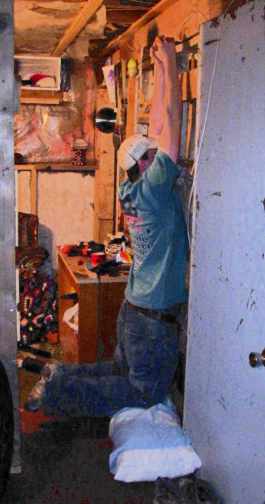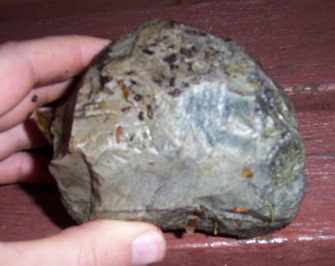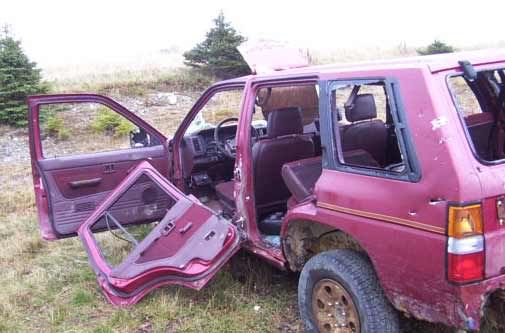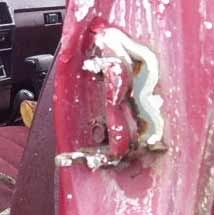
A stock Howling Rat from the Swamp Rat Knives website:

A shot of a heavily used Camp Tramp and Howling Rat :

The Howling Rat weighs 185 grams and balances about a half a centimeter behind the guard. It has a 4.5" blade made by stock removal out of 3/16" thick SR101 ("enhanced" 52100) uniformly hardened to 58-60 HRC. The primary grind is high sabre flat tapering to a edge which is lightly convex and 0.031 - 0.038" thick ground at 17-18 degrees per side. It has a synthetic grip of "Resiprene C", a dense synthetic rubber like material and a hard black crinkle epoxy coating coating to enhance the corrosion resistance of the blade.
The Howling Rat required 30-32 lbs to push cut 3/8" hemp at the base and 32-34 lbs near the tip and little aggression on a slice taking 28 (1) lbs on a 2" draw. On basswood, it took 10.1 (0.8) slices to form a one inch point showing solid carving ability.
The tip of the Howling Rat is rather thin with a slight convex curvature. It is approximately ground at 4.6 (3) degrees through one inch. The penetration is high, 627 (8) pages into a phone book on a vertical stab. However the point is still of a decently robust nature and could readily dig holes in various stock lumber taking on average 33 (2) stabs, making the holes in 3.2 (2) minutes.
With the initial sharpness, the Howling Rat was unable to cut well foods like plums and tomatoes as there was excessive slipping on the skin because of the give of the underlying very soft tissue. However once sharpened, it cut these foods as well as other soft materials like meats, and other fruits and most vegetables, as these foods just depends on a sharp edge to be cut well and are not significantly influenced by geometry except in extremes.
It doesn't work well as a paring knife as it is too wide and on thicker foods which are solid enough to cause binding or wedging on the knife, the Howling Rat falls behind an truely optimized kitchen knife. It cuts through a medium size carrot with 5-7 lbs while a Japanese utility knife does it in 2.5 - 3 lbs. It also tends to crack carrots on very thin slices.
The blade has little mass and a neutral balance and thus can't chop efficiently even with snap cuts around the end of the grip. There is simply not enough heft to be able to generate power on a swing or with a wrist snap. A few trials against a Wildlift hatchet showed that the Howling Rat needed about five swings for every one hit with the hatchet to achive the same level of penetration. However the Howling Rat can be used effectively with a baton and can cut and split woods up to say 2.5 inches without a large amount of effort. However such baton work is still many to one times slower than with a knife that has enough weight and forward balance to chop effectively. On larger wood a long blade is much more effective as it reduces the number of splits and in general wedges are more efficient.
Cutting a variety of light materials like bubble wrap, plastics, paper and fabrics, the Howling Rat did well as these materials are too flimsy to exert any pressure on a blade so as long as it is sharp it will cut that class of material well. However on really thick cardboard it is outcut by thinner blades which is best suited to something like an Opinel.
In responce to a 3/16" p-ATAK from Kevin McClung breaking the question was raised about expected performance. As usual McClung deleted posts on his forum where he attacked the reviewer, similar to how he responded to the second TUSK failure. In any case the Howling Rat was subjected to extreme work to show an example of high end knife performance in such situations. This blade has been heavily used and sharpened and the edge angle reduced to about 10 degrees per side so the strength and durability exhibited in what follow is actually lower than can be expected by a stock blade. First the Howling Rat was subjected to a moderate load :

This is a 215+ individual hanging from the Howling Rat, inserted to one inch from the handle between two pieces of 2x4 nailed together along the sides of the knife to prevent excessive deformation in the wood. The knife shows little flex. The Howling Rat was then pounded into a tree (22 oz framing hammer) two inches from the tip, and it was stood on (190 lbs). It was difficult to apply full bodyweight as the knife bent slightly so a limb was used for stability. To eliminate this factor the knife was pounded into the tree higher up and then hung from, again two inches from the tip. This failed to produce a significant flex. It was then pounded in a mere one inch from the tip and again full 190 lbs was applied, the blade bent down to 45, but a lot of the angle was induced because the wood was getting smashed down. The blade itself was still not bending excessively. As the main complaint in the above custom test was the impacts, the Howling Rat was chopped into a rock 75 times. These were chops hard enough to throw off sparks about a foot long and readily cut a piece out of the rock, ref :

and the knife :

The notch in the rock is 0.5-1.0 cm deep. The hacking failed to produce significant edge damage (0.010-0.020" thick) to the Howling Rat. The knife was then heavily hacked into the rock a further 25 times at the same point on the edge, which finally damaged the edge to about 0.030" deep. The prying was then repeated at two and one inches from the tip and again the knife held 190 lbs without harm. The Howling Rat was finally pounded 0.5 and 0.75" into the tree and enough force applied to break it clear. Again no damage was done to the knife. All the hammering on the but did however do some cosmetic damage to the butt of the handle, and did smash in slighty the laynard eyelet.
In contrasting the results of the p-ATAK vs the performance of the Howling Rat, note that the Howling Rat showed significantly greater strength and toughness while being thinner and ground with a much more acute edge profile than the p-ATAK, the latter is also selectively tempered with a spring spine while the Howling Rat is through hardened. The Howling Rat is also costs much less. As further even more extreme work, a 28 oz framing hammer was used to cut the hinges off A SUV with the Howing Rat and a Agent from Dozier. The first impacts on the Agent were light as the feedback to the grip was high. The Agent cracked immediately and sharded into pieces. No progress was made in the cutting. The Howling Rat went through the first hinge easily, no edge damage, just dulling.

In retrospect a new part of the blade should have been used on the lower hinge because it was having difficultly as the edge was blunted and it was bouncing out of the cut. A clean cut made through both the top and bottom part of the upper hinge hinge :

A close up :

On the bottom of the picture note the piece of the hinge sticking out unattached, attempting to cut through that the Howling Rat broke under the heavy impacts of the hammer. That part of the hinge was bending under the strain and thus the impacts were torquing sideways on the edge. A better method would have been to cut the bottom hinge first as this would have left the top one still fairly rigid. Of course from a practical escape senario, once the top hinge was gone the door was no longer any hinderance in getting out of the car. The knives :

The steel in the Howling Rat is strong enough to prevent excessive rolling, impaction or other type of deformation and is tough enough to resist extensive fracture with solid wear resistance. Thus in general there is little metal removed from the edge in use and the high grindability and low burr formation means ease of sharpening is in general high. However the corrosion resistance isn't high (between A2 and O1) and thus sharpening can be extensive in corrosive enviroments due to edge damage from corrosion. After extensive work the edge was blended back into the primary grind with the apex taper of about ten degrees per side to optomize the knife for wood working, trading durability for cutting ability.
The grip on the Howling Rat is made of a "Resiprene C", a dense rubber like material which is more durable than Kraton, but far less than Micarta or G10. It has a decent texture and is contoured in all dimensions. However the front of the grip is rather squarish and limits force when cutting as the corners are high pressure points. Ideally the front of the handle should be blended into the blade so as to give a nice form fitting shape for an overhand grip. A longer guard would also be nice for more security in extreme circumstances. The rear butt hook is well shaped providing a strong combination of security and ergonomics.
The sheath is Cordura with a Kydex insert. It came with a fairly loose fit though not enough to induce any rattle. There is a nice pouch on the sheath with an elastic tie down. It is all held together with secure and quality stitching.
The Howling Rat is essentially a more robust version of the MEUK- 52100 which trades cutting ability for a much more robust blade which enables much heavier work. It is well suited to the steel which has a decent balance of hardness, toughness and abrasion resistance. In regards to the lack of a differential heat treatment for the smaller Swamp Rats - smaller knives generally don't recieve the very harsh pounding of larger knives and thus don't need the much greater impact toughness on the spine aside from the really insane levels of use such as noted in the above.
Comments can be sent to : cliffstamp[REMOVE]@cutleryscience.com or by posting in the following thread :
More information can be obtained at the Swamp Rat Knife works website, which also includes a discussion board. Some firecraft with a Howling Rat :
| Last updated : | 01 : 25 : 2006 |
| Originally written : | 01/29/2003 |